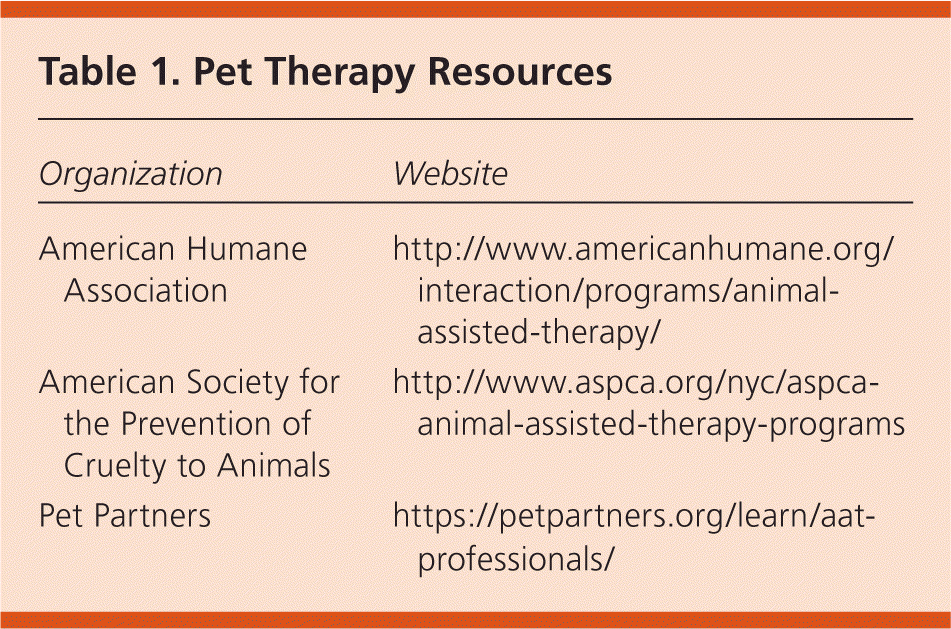
Am Fam Physician. 2016;94(9):737-740
Author disclosure: No relevant financial affiliations.
Case Scenario
A 16-year-old girl and her parents presented to my office for her wellness evaluation. The patient has generalized anxiety disorder with comorbid major depression, for which she has been prescribed a serotonergic antidepressant. She is a high school student, lives with her parents, and is currently preparing college applications. She has occasional headaches and disturbed sleep. She takes daily three-mile walks and plays on her school tennis team, both of which help relieve her anxiety symptoms. The therapist she sees once a week has suggested enrollment in a therapeutic foster dog walking program to help further relieve her anxiety symptoms.
Would animal-assisted therapy be helpful as a part of anxiety and depression management in this patient? Would such treatment be a helpful approach for other teenaged patients in my practice with similar diagnoses?
Commentary
Therapeutic animal companionship can improve patients' well-being through time spent with pets. It is typically divided into two categories: animal-assisted activities and animal-assisted therapy. Both types of companionship can have physical and psychosocial benefits. Animal-assisted activities are loosely defined as animal-associated motivational, recreational, educational, or therapeutic activities that are conducted by volunteers to enhance quality of life.1 Most commonly, animals are brought into facilities such as hospitals, long-term care facilities, and university residences and allowed to interact with people around them. These programs have been implemented worldwide. Although this type of social interaction with animals and their handlers can provide physical and psychosocial benefits, the goals of animal-assisted activities are nonspecific and nontargeted.
Conversely, animal-assisted therapy is a structured, clearly defined, and goal-directed program that incorporates trained companion animals into therapeutic settings to enhance progression toward individualized treatment benchmarks.1 Objectives of therapy with animals may be behavioral, motivational, physical, mental, or educational in nature.2 Dogs are the most commonly used animals. Animal-assisted therapy has been shown to have positive effects in some populations; however, it can elevate the risk of zoonotic infections, and bites and scratches are an ongoing risk. Animal-assisted therapy may be contraindicated in persons with allergies, fear of animals, and a higher risk of zoonotic infections (e.g., patients who are immunocompromised).3–5 Animal and handler characteristics and training, as well as other factors, such as risk of pathogen shedding, must be considered to help mitigate these risks.
There is growing evidence that supports the use of animal-assisted therapy as complementary or adjunctive therapy for various clinical conditions in primary care and emergency department settings1; however, evidence is limited by study methodology and interpretation.1,3 In one early study, pet ownership was associated with increased survival in a cohort of patients with angina pectoris or myocardial infarction.6 In 2013, the American Heart Association recommended that owning a pet, especially a dog, might be reasonable for reduction of cardiovascular disease risk.7 Therapy dog visitation in the outpatient setting has been associated with reduction in pain severity in adults with fibromyalgia,8 and canine visitation therapy and animal-assisted therapy have been associated with decreases in perceived postoperative and other pain in children.9,10 Visits from a therapy dog have produced a similar reduction in perceived postoperative pain in adult patients.11
Although objective assessment of outcomes is difficult, animal-assisted therapy has psychosocial benefits. Pet ownership was associated with decreased anxiety in one cross-sectional study of children at a pediatric primary care clinic.12 Animal-assisted therapy has been associated with qualitative and physiologically measurable reductions in stress, pain, and anxiety; positive increases in mood; decreases in fatigue; improvement in clinical variables related to posttraumatic stress disorder; and positive psychosocial variables and therapeutic progress in children and adults.13–20 Serum markers (including oxytocin, prolactin, cortisol, dopamine, phenylacetic acid, and β-endorphin) associated with social bonding, social attachment, pleasurable sensations, pain reduction, and stress relief are improved by positive interactions with dogs.20
Despite limitations in study methodology, it is reasonable to conclude that animal-assisted therapy may help the high school student in this case scenario, and others with similar diagnoses, control anxiety and depression symptoms. It could potentially heighten positive mood,14,15 allow her to achieve educational and mental health goals,14,15 and facilitate communication with the therapist, physician, and others.14,15 As an otherwise healthy patient with no evident contraindications or factors that would increase the risk of a zoonotic infection, the risks posed by animal contact in this situation are likely very low. It is important that any animals presented to or immersed in a human health care setting, or involved in physician-directed activities, be carefully managed. The Society for Healthcare Epidemiology of America Guidelines Committee has outlined practical and easily implemented animal health care policies that medical professionals can follow to ensure patient and animal safety.21 Table 1 provides additional resources for learning about pet therapy.

| Organization | Website |
|---|---|
| American Humane Association | http://www.americanhumane.org/interaction/programs/animal-assisted-therapy/ |
| American Society for the Prevention of Cruelty to Animals | http://www.aspca.org/nyc/aspca-animal-assisted-therapy-programs |
| Pet Partners | https://petpartners.org/learn/aat-professionals/ |
